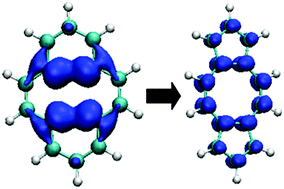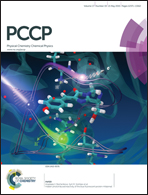The electronic states of a double carbon vacancy defect in pyrene: a model study for graphene†
Abstract
The electronic states occurring in a double vacancy defect for graphene nanoribbons have been calculated in detail based on a pyrene model. Extended ab initio calculations using the MR configuration interaction (MRCI) method have been performed to describe in a balanced way the manifold of electronic states derived from the dangling bonds created by initial removal of two neighboring carbon atoms from the graphene network. In total, this study took into account the characterization of 16 electronic states (eight singlets and eight triplets) considering unrelaxed and relaxed defect structures. The ground state was found to be of 1Ag character with around 50% closed shell character. The geometry optimization process leads to the formation of two five-membered rings in a pentagon–octagon–pentagon (5–8–5) structure. The closed shell character increases thereby to ∼70%; the analysis of unpaired density shows only small contributions confirming the chemical stability of that entity. For the unrelaxed structure the first five excited states (3B3g, 3B2u, 3B1u, 3Au and 1Au) are separated from the ground state by less than 2.5 eV. For comparison, unrestricted density functional theory (DFT) calculations using several types of functionals have been performed within different symmetry subspaces defined by the open shell orbitals. Comparison with the MRCI results gave good agreement in terms of finding the 1Ag state as a ground state and in assigning the lowest excited states. Linear interpolation curves between the unrelaxed and relaxed defect structures also showed good agreement between the two classes of methods opening up the possibilities of using extended nanoflakes for multistate investigations at the DFT level.


 Please wait while we load your content...
Please wait while we load your content...